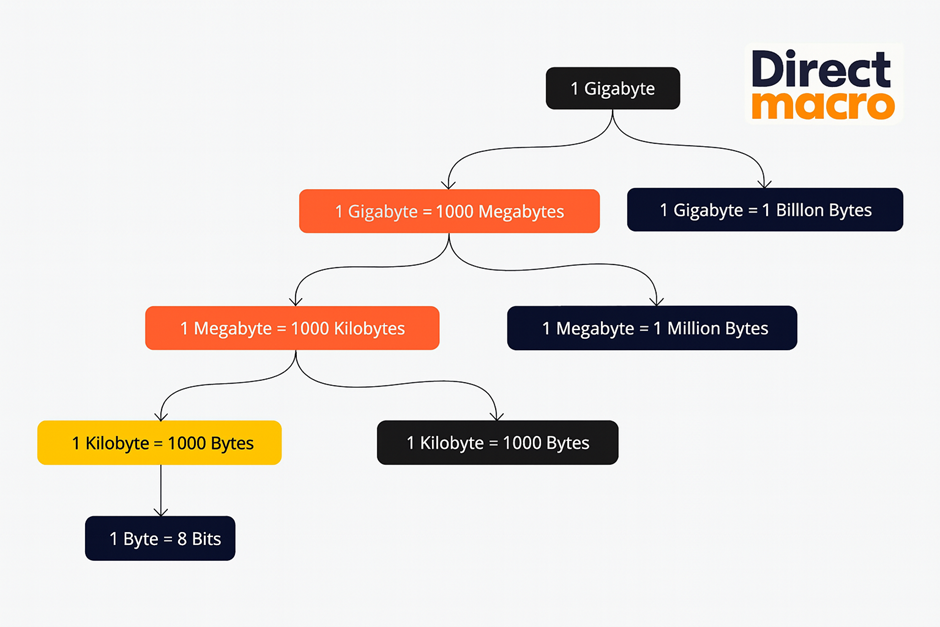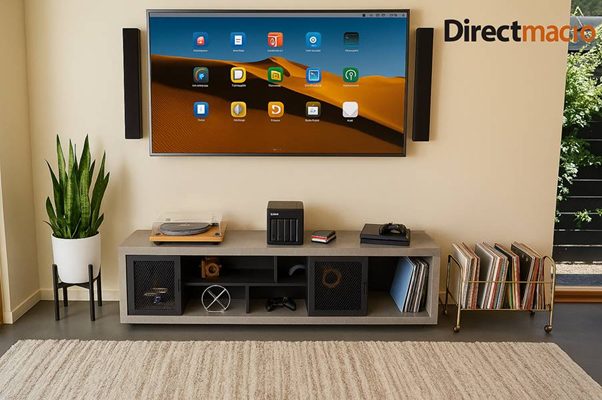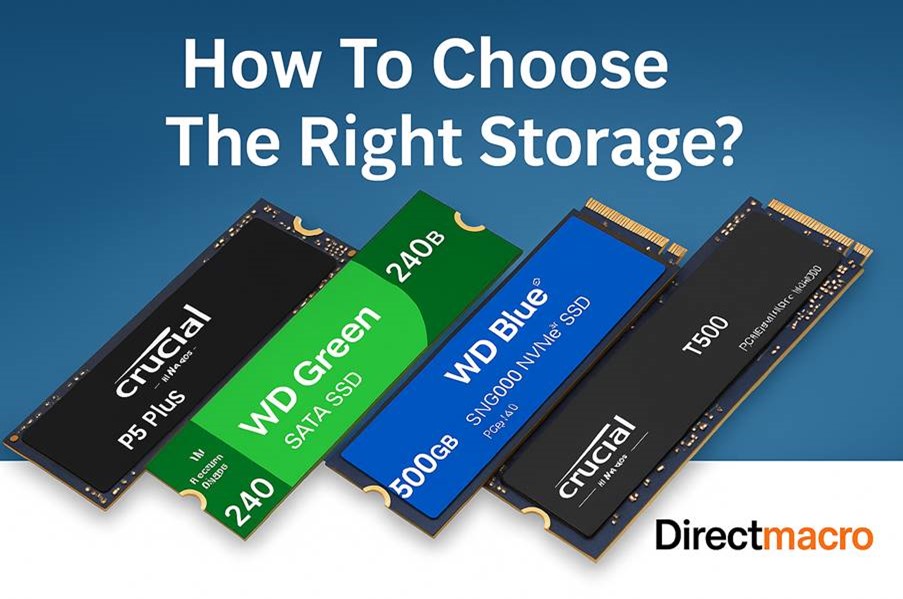MB vs GB: Difference Between Megabyte and Gigabyte
In today’s world, data is just as crucial as everything else, and mastering its management is extremely important. Whether you are content creators, gamers, or individuals who are simply trying to understand how to optimize mobile storage, the terms megabyte (MB) and gigabyte (GB) are everywhere. This guide aims to explore the significance of these concepts and their impact on your daily digital life.
Understanding the Basics of MB and GB
What is a Megabyte?
A megabyte (MB) is represented as a unit of digital information storage. The word mega means a million; therefore, a megabyte is equal to one million bytes. However, computers work in a binary nature, so a megabyte is defined as 1,024 kilobytes (KB). To put that into perspective, a single byte consists of eight bits. A bit is the smallest unit of data, represented as either a one or a zero.
For Example: A single character, like the letter ‘A,’ is one byte. A kilobyte is approximately one thousand characters, and a megabyte is a thousand of those. It is the unit you will come across for smaller files, such as:
- Standard-Resolution Photos: A typical JPEG image from a smartphone typically ranges in size from 2 to 5 MB.
- MP3 Audio Files: A 3-minute song typically ranges in size from 3 to 6 MB.
- Simple Documents: A plain text document or a basic PDF is often measured in kilobytes or a few megabytes.
What is a Gigabyte?
A gigabyte is a much bigger unit of digital storage than a megabyte. The word giga represents a billion, so a gigabyte is roughly one billion bytes. In terms of computer science, a gigabyte is equivalent to 1,024 megabytes. This exponential scaling enables us to store massive amounts of data.
To understand the size of a gigabyte in context, consider what you can store with it:
- High-Definition Movies: A full-length HD movie can easily be 2-4 GB in size.
- Video Games: Modern video games can take up 10 or even 100s of gigabytes.
- Software and Apps: Large applications, such as video editing software or operating systems, are measured in gigabytes.
The comparison is clear between MBs and GBs. MBs are for smaller and individual files; on the other hand, GBs are for larger collections of files, entire applications, and rich media.
The Impact of MB and GB on Data Storage Management

To manage data storage efficiently, you must understand the difference between an MB and a GB. This differentiation helps you to understand whether your hard drive has enough space for a single photo or an entire video project.
Here is how these units impact storage:
1. Device Capacity
When you buy a smartphone, computer, or external hard drive, its storage capacity is almost always advertised in gigabytes (GB) or terabytes (TB). Knowing that 1 GB holds 1,024 MB helps you calculate how many files you can store. For example, a 64 GB phone can store approximately 12,800 photos (assuming each is 5 MB) or 16 HD movies (assuming each is 4 GB), which can help you decide whether to purchase the 64 GB phone or its competitor.
2. Mobile Data Plans
Your monthly mobile data plan charges you in gigabytes. If you are paying for a phone plan with limited data, streaming a high-definition movie or engaging in video calling for an hour can use up a significant portion of your data. On the other hand, casual web browsing and messaging are charged in megabytes, so they consume data at a much slower rate. Understanding this helps you manage your data usage and avoid overage charges.
3. Cloud Storage
Google Drive, iCloud, and Dropbox all offer different cloud storage services with varying plans for storage space in gigabytes. The fundamental plans offered for free have around 5GB or a few gigabytes, and even paid plans can scale up to terabytes. In this scenario, you need to assess your needs, whether you only require backing up documents, which are typically a couple of megabytes in size, or an entire photo and video library, which can be several gigabytes or even terabytes in size.
Understanding the scale of these data units helps you make informed choices about purchasing devices, allocating your data plan budget, and managing your digital clutter.
What Is the Difference Between Megabyte and Gigabyte?
The difference between a megabyte and a gigabyte is a simple matter of scale. A gigabyte is a thousand times larger than a megabyte. This difference is crucial for understanding the relationship between file sizes and storage capacities.
For a practical example, consider a digital music library. If a single song is around 5 MB, you could fit about 200 songs in a single gigabyte. Hence, a full album with 12 songs would be roughly 60 MB. That is why you can store thousands of songs in a smartphone, which typically has storage in the hundreds of gigabytes.
Comparison Chart: MB vs. GB
| Characteristic | Megabyte (MB) | Gigabyte (GB) |
| Size | Smaller unit of data | Larger unit of data |
| Value (Decimal) | 1,000,000 bytes | 1,000,000,000 bytes |
| Value (Binary) | 1,048,576 bytes (220) | 1,073,741,824 bytes (230) |
| Conversion | 1,024 MB = 1 GB | 1 GB = 1,024 MB |
| Common Use | Small files: photos, documents, music files | Large files: videos, software, video games, device storage capacity |
What Is the Difference Between Gigabytes and Gigabits?
This confusion is quite common, and it is essential to get it accurate, especially when dealing with internet connection speed. A gigabyte (GB) defines the capacity of storage, while a gigabit (Gb) defines data transfer speed. The difference is merely a single letter, the lowercase “b” representing bits and the uppercase “B” representing bytes.
Keep in mind that 1 byte is equal to 8 bits. It means that 1 gigabit is equivalent to 1/8 the size of 1 gigabyte. Thus, an internet connection of 1 Gbps (gigabits per second) can download an 8 GB file in 8 seconds (ignoring real-world factors, such as latency).
When an internet service provider advertises 1 Gbps speeds, it is referring to the transfer rate, not the amount of data offered. The data presented differs from the transfer rate, which is the maximum speed at which your data can be transmitted. Not the size of your monthly data cap. On the other hand, your data cap is measured in GB.
Comparison Chart: Gigabytes vs. Gigabits
| Feature | Gigabyte (GB) | Gigabit (Gb) |
| Unit Type | Data storage/size | Data transfer speed |
| Basic Definition | 1 GB = 8 Gb (since 1 byte = 8 bits) | 1 Gb = 0.125 GB |
| Used For | File size, drives, RAM, backups | Internet speed, network bandwidth |
| Conversion Example | 1 GB = 8,000,000,000 bits | 1 Gb/s ≈ 125 MB/s transfer rate |
| Real-World Context | Selecting storage capacity | Understanding how fast data downloads/uploads |
Understanding this difference is beneficial for both consumers and businesses. You might have a blazing-fast 1 Gbps internet connection, but if your monthly data limit is only 20 GB, you will quickly reach your cap with heavy usage.
How MBs and GBs Help Us Choose the Right Storage?
You can understand the units, so now you should have the confidence to choose the correct device or storage solution that works best for you. It comes down to what you actually need.
Gigabyte-Size Storage Options and Pricing
The price of storage has decreased over the years, making high-capacity drives more accessible than ever. Here is a general guide to storage options and the associated costs. Remember that prices vary significantly by brand, technology (such as SSD vs. HDD storage devices), and retailer.
-
Low-End Storage (16GB – 64GB)
You can usually find this amount of storage on inexpensive smartphones, tablets, and USB flash drives. It is suitable for individuals who primarily use the internet, social media, and store a limited number of images and documents. You may need to frequently move data to the cloud or an external storage location.
-
- Typical User: The minimalist, the casual user.
-
Mid-Range Storage (128GB – 512GB)
It is the best size for most consumers. You can find this range in standard laptops, tablets, and mid-range to high-end smartphones. It has ample space for thousands of images, dozens of videos, an extensive music collection, and a substantial number of applications.
-
- Typical User: The average user, students, and professionals.
-
High-End Storage (1TB and up)
Terabytes (TB) are the next step up, equivalent to 1,024 GB. It is typical for modern PCs, game consoles, and high-end external hard drives. This much space is perfect for:
- Gamers: A TB drive is necessary because modern video games can range in size from 50 GB to 200 GB.
- Content Creators: ITB is ideal for videographers and photographers who deal with big, high-resolution files.
- Data Hoarders: This storage option is ideal for individuals who require storing a large amount of data, such as movies, TV series, and extensive software libraries.
Pricing Guidance
When considering pricing, remember that cloud storage is often a subscription service, whereas physical storage is a one-time purchase. For example, a 1TB external hard drive may require a one-time fee, whereas 1TB of cloud storage typically comes with a monthly or annual subscription.
- USB Flash (128–256 GB): Typically, priced under $30–$50.
- SSD (512 GB – 1 TB): Around $50–$120, depending on speed.
- HDD (1 TB – 4 TB): $40–$120, depending on RPM and brand.
- Premium SSDs (2 TB+ NVMe): $180–$350 based on performance.
Buying Tips
Here are some buying tips you need to consider before purchasing MB, GB, or TB
- A 256GB flash memory or drive is typically sufficient for documents and streaming.
- Opt for a 1TB+ SSD for faster load times and future-proofing for gaming or large media libraries.
- To determine real usable capacity, always check whether a listing uses GB (decimal) or GiB (binary).
Comparison Chart
| Storage Tier | Common Use | Approx. Price* |
| 128–256 GB | Light media, documents, basic apps | $30–$50 |
| 512 GB – 1 TB | Smartphone storage, SSDs for laptops | $50–$120 |
| 1–2 TB (HDD/SSD) | Extensive media, backups, gaming | $80–$200 |
| 2 TB+ (NVMe SSDs) | Video editing, professional workflows | $180–$350 |
Conclusion
The world of data is built on a foundation of bits and bytes, with megabytes and gigabytes serving as the key benchmarks for measuring digital information. Understanding the meaning of these terms can help you gain a powerful tool for managing your digital life. You can confidently choose the right devices, choose an appropriate data package, and organize your files efficiently. Always keep in mind that MBs are for your everyday files, while GBs are for your entire digital world.
For more assistance and support please contact us at (855) 483-7810 or visit our website for direct information on bulk purchases.
FAQs
- How many files are in a gigabyte?
It is a tricky question because file sizes vary dramatically. However, we can provide some estimates:
- Photos: A gigabyte can hold hundreds to thousands of images. It depends on the resolution and file format. A 5 MB photo means you can store about 200 pictures per GB.
- Songs: You could store over 200 songs in a single GB with an average MP3 file size of 5 MB.
- Documents: Simple text documents and files usually consume a few kilobytes, so that you could fit hundreds of thousands of them in a GB. A large PDF can take up several megabytes.
- HD Videos: High-definition videos can range from 1 GB to 5 GB per hour of footage. A GB might only hold a few minutes to an hour of video.
- How Many MB in a GB?
There are 1,024 MB in a GB. While some storage manufacturers use a base-10 system for marketing purposes, where 1 GB equals 1,000 MB, others use a base-2 system, where 1 GB equals 1,073,741,824 bytes. The computers use a binary system, which means the correct conversion is 1,024. That is why a 500 GB hard drive often shows up as 465 GB on your computer. The operating system uses the more precise binary measurement.
- How long does it take to use 1 GB of data?
It entirely depends on how you are using your data. Here are some estimates for mobile data usage:
- If you are using your data for casual browsing, it can only be consumed for a few hours.
- The date usage for streaming music is about to end after 10-15 hours of streaming audio.
- Streaming Standard-Definition Videos consumes 1GB in around 1 to 2 hours.
- If you are streaming high-definition videos, it takes as little as 20 minutes to an hour to use up the data, as HD video consumes data very quickly.
Understanding these scales helps you to manage your mobile data package and avoid unexpected extra charges.
Do you need advice on buying or selling hardware? Fill out the form and we will return.

Sales & Support
(855) 483-7810
We respond within 48 hours on all weekdays
Opening hours
Monday to thursday: 08.30-16.30
Friday: 08.30-15.30







